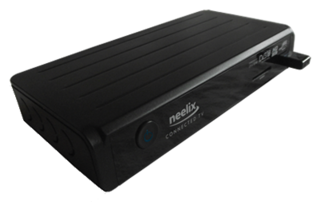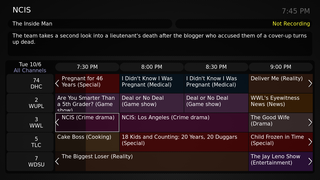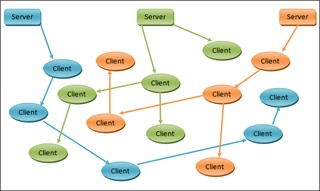
A set-top box (STB), also colloquially known as a cable box or receiver and historically television decoder, is an information appliance device that generally contains a TV-tuner input and displays output to a television set and an external source of signal, turning the source signal into content in a form that can then be displayed on the television screen or other display device. They are used in cable television, satellite television, and over-the-air television systems as well as other uses.

Digital Video Broadcasting (DVB) is a set of international open standards for digital television. DVB standards are maintained by the DVB Project, an international industry consortium, and are published by a Joint Technical Committee (JTC) of the European Telecommunications Standards Institute (ETSI), European Committee for Electrotechnical Standardization (CENELEC) and European Broadcasting Union (EBU).

Bell Satellite TV is the division of BCE Inc. that provides satellite television service across Canada. It launched on September 10, 1997. As of April 2017, Bell Satellite TV provides over 700 channels to over 1 million subscribers. Its major competitors include satellite service Shaw Direct, as well as various cable and communications companies across Canada.
Streaming television is the digital distribution of television content, such as television shows and films, as streaming media delivered over the Internet. Streaming television stands in contrast to dedicated terrestrial television delivered by over-the-air aerial systems, cable television, and/or satellite television systems.

Internet Protocol television (IPTV) is the delivery of television content over Internet Protocol (IP) networks. This is in contrast to delivery through traditional terrestrial, satellite, and cable television formats. Unlike downloaded media, IPTV offers the ability to stream the source media continuously. As a result, a client media player can begin playing the content almost immediately. This is known as streaming media.
The Freebox is an ADSL-VDSL-FTTH modem and a set-top box that the French Internet service provider named Free provides to its DSL-FTTH subscribers.

Malaysian television broadcasting was introduced on 28 December 1963. Colour television was introduced on 28 December 1978. Full-time colour transmissions were officially inaugurated on New Year's Day 1982. There are currently 16 national free-to-air terrestrial television channels in Malaysia and 3 national pay subscription television operators in Malaysia.

Electronic programming guides (EPGs) and interactive programming guides (IPGs) are menu-based systems that provide users of television, radio and other media applications with continuously updated menus that display scheduling information for current and upcoming broadcast programming. Some guides also feature backward scrolling to promote their catch up content. They are commonly known as guides or TV guides.

Sky Angel was a U.S. operator of Christian television networks; it operated three channels, Angel One, Angel Two, and KTV, all of which were exclusive to Dish Network. The company's corporate headquarters were located in Naples, Florida. The company also operated a Chattanooga, Tennessee location where programming, engineering and network operations resided.
Subscription television in Australia is provided using technologies such as cable television, satellite television and internet television by a number of companies unified in their provision of a subscription television service. Notable actors in the sector include Foxtel, Netflix and Stan. Regulation of the sector is assured by the Australian Communications and Media Authority.

P2PTV refers to peer-to-peer (P2P) software applications designed to redistribute video streams in real time on a P2P network; the distributed video streams are typically TV channels from all over the world but may also come from other sources. The draw to these applications is significant because they have the potential to make any TV channel globally available by any individual feeding the stream into the network where each peer joining to watch the video is a relay to other peer viewers, allowing a scalable distribution among a large audience with no incremental cost for the source.

Star Hub TV is a pay television service provided by StarHub in Singapore. It has been a subsidiary of StarHub Limited since StarHub acquired Singapore Cable Vision (SCV) in 2001, and was the sole pay-TV operator in the country until 2007 when mio TV, an IPTV service from its competitor, Singtel, was launched.
Now TV is a pay-TV service provider in Hong Kong operated by PCCW Media Limited, a wholly owned subsidiary of PCCW. Launched on 26 September 2003, its TV signal is transmitted with IPTV technology through HKT's fixed broadband network.
Moldtelecom is the national telecommunications operator and also the largest telecommunications company in the Republic of Moldova.
Television in Iceland is currently composed of the public broadcasting service of RÚV, five free-to-view channels and a number of subscription channels provided by private broadcasters. Broadcasts began in 1955 when the American Forces Radio and Television Service (AFRTS) started an English-language television service broadcasting from Naval Air Station Keflavik, which operated until 2006. The first Icelandic-language television broadcasts started in September 1966 with the launch of RÚV, originally called Sjónvarpið. In 1986 the first privately owned TV station, Stöð 2, began broadcasts. In recent years the emergence of foreign internet streaming services such as Netflix and Disney+ has seen shift from domestic providers provide similar on demand streaming services such as Síminn Premium and Stöð 2+.

MEO is a mobile and fixed telecommunications service and brand from Altice Portugal, managed by MEO - Serviços de Comunicações e Multimédia. The service was piloted in Lisbon in 2006 and was later extended to Porto and Castelo Branco.
The television industry in China includes high-tech program production, transmission and coverage. China Central Television is China's largest and most powerful national television broadcaster. By 1987, two-thirds of people in China had access to television, while today, over 3,000 channels are available in the country.

Bell Fibe TV is an IP-based television service offered by Bell Canada in the provinces of Ontario and Quebec. It is bundled with a FTTN or FTTH Bell Internet service, and uses the Mediaroom platform. Bell Fibe TV officially launched on September 13, 2010. It is also available in Manitoba and Atlantic Canada, where Fibe TV is re-packaged, being offered by Bell MTS and Bell Aliant with similar services and integrated with Bell Fibe TV.
The distribution of cable television around the world:









